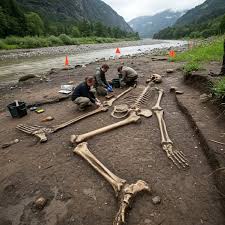Giant Skeleton Unearthed in Remote Valley—History’s Biggest Cover-Up
The sensational headline “Giant Skeleton Unearthed in Remote Valley—History’s Biggest Cover-Up” is a classic example of a recurring and widespread hoax. There have been no credible archaeological discoveries of giant human skeletons. The story, often accompanied by doctored photos showing a human next to a massive, fabricated skeleton, is a staple of online misinformation and is not supported by any scientific evidence.

The myth of giant humans is rooted in folklore and ancient texts from cultures around the world, but it has never been confirmed by the physical archaeological record. In many cases, these hoaxes are based on a misinterpretation of real finds. For instance, in the 19th century, people would often mistake the massive bones of prehistoric animals, such as mammoths or dinosaurs, for the remains of mythical human giants. Today, with digital technology, it is relatively easy to create a fake image that appears to show a colossal skeleton, fueling the conspiracy theory narrative of a “cover-up” to explain the absence of real evidence.

However, a real and groundbreaking discovery was made in a remote valley that genuinely challenged our understanding of human history: the “Hobbit” skeleton (Homo floresiensis). In 2003, archaeologists working in a remote cave on the Indonesian island of Flores unearthed the remains of a small, human-like species that stood just over three feet tall. This discovery was truly revolutionary, as it proved that another human species had survived and coexisted with modern Homo sapiens as recently as 50,000 years ago. This genuine finding, though it involved a small skeleton rather than a giant one, demonstrates that the real discoveries in remote corners of the world are often far more compelling and scientifically valuable than any fictional story of giants.
